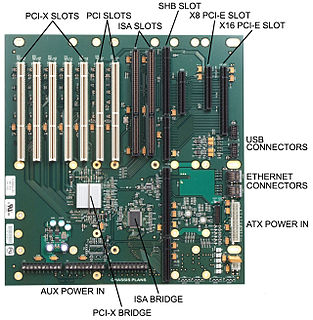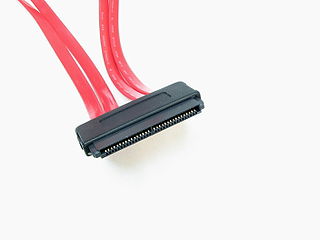
A backplane is a group of electrical connectors in parallel with each other, so that each pin of each connector is linked to the same relative pin of all the other connectors, forming a computer bus. It is used as a backbone to connect several printed circuit boards together to make up a complete computer system. Backplanes commonly use a printed circuit board, but wire-wrapped backplanes have also been used in minicomputers and high-reliability applications.
In computing, iSCSI is an acronym for Internet Small Computer Systems Interface, an Internet Protocol (IP)-based storage networking standard for linking data storage facilities. It provides block-level access to storage devices by carrying SCSI commands over a TCP/IP network. iSCSI is used to facilitate data transfers over intranets and to manage storage over long distances. It can be used to transmit data over local area networks (LANs), wide area networks (WANs), or the Internet and can enable location-independent data storage and retrieval.

Serial ATA is a computer bus interface that connects host bus adapters to mass storage devices such as hard disk drives, optical drives, and solid-state drives. Serial ATA succeeded the earlier Parallel ATA (PATA) standard to become the predominant interface for storage devices.
A disk array controller is a device which manages the physical disk drives and presents them to the computer as logical units. It almost always implements hardware RAID, thus it is sometimes referred to as RAID controller. It also often provides additional disk cache.

A disk enclosure is a specialized casing designed to hold and power disk drives while providing a mechanism to allow them to communicate to one or more separate computers.
In computer storage, a logical unit number, or LUN, is a number used to identify a logical unit, which is a device addressed by the SCSI protocol or Storage Area Network protocols which encapsulate SCSI, such as Fibre Channel or iSCSI.
SCSI target devices provide a number of SCSI diagnostic pages. These can be used by a Send Diagnostic command to tell a target device to run a specialised self-test. The Receive Diagnostic Results command is used where the results from the self-test operation are non-trivial.
SCSI Enclosure Services (SES) devices contains a number of elements, each of which is defined by a one byte SCSI element code. There are many different element codes defined to cover various devices as shown in the list below.
A SCSI connector is used to connect computer parts that use a system called SCSI to communicate with each other. Generally, two connectors, designated male and female, plug together to form a connection which allows two components, such as a computer and a disk drive, to communicate with each other. SCSI connectors can be electrical connectors or optical connectors. There have been a large variety of SCSI connectors in use at one time or another in the computer industry. Twenty-five years of evolution and three major revisions of the standards resulted in requirements for Parallel SCSI connectors that could handle an 8, 16 or 32 bit wide bus running at 5, 10 or 20 megatransfer/s, with conventional or differential signaling. Serial SCSI added another three transport types, each with one or more connector types. Manufacturers have frequently chosen connectors based on factors of size, cost, or convenience at the expense of compatibility.

Parallel SCSI is the earliest of the interface implementations in the SCSI family. SPI is a parallel data bus; There is one set of electrical connections stretching from one end of the SCSI bus to the other. A SCSI device attaches to the bus but does not interrupt it. Both ends of the bus must be terminated.
The Enclosure Services Interface (ESI) is a computer protocol used in SCSI enclosures. This is part of a chain of connections that allows a host computer to communicate with the enclosure to access its power, cooling, and other non-data characteristics. This overall approach is called SCSI attached enclosure services:
SCSI standalone enclosure services is a computer protocol used mainly with disk storage enclosures. It allows a host computer to communicate with the enclosure to access its power, cooling, and other non-data characteristics.
In computer storage, SAF-TE is an industry standard to interface an enclosure to a (parallel) SCSI subsystem to gain access to information or control for various elements and parameters. These include temperature, fan status, slot status (populated/empty), door status, power supplies, alarms, and indicators. Practically, any given SAF-TE device will only support a subset of all possible sensors or controls.

The International Blinking Pattern Interpretation (IBPI) is an internal computer hardware standard. It defines two items:
- How SGPIO is interpreted into states for drives or slots on a backplane.
- How light emitting diodes (LEDs) on a backplane should represent these states.
SCSI / ATA Translation (SAT) is a set of standards developed by the T10 subcommittee, defining how to communicate with ATA devices through a SCSI application layer. The standard attempts to be consistent with the SCSI architectural model, the SCSI Primary Commands, and the SCSI Block Commands standards.
USB Attached SCSI (UAS) or USB Attached SCSI Protocol (UASP) is a computer protocol used to move data to and from USB storage devices such as hard drives (HDDs), solid-state drives (SSDs), and thumb drives. UAS depends on the USB protocol, and uses the standard SCSI command set. Use of UAS generally provides faster transfers compared to the older USB Mass Storage Bulk-Only Transport (BOT) drivers.






